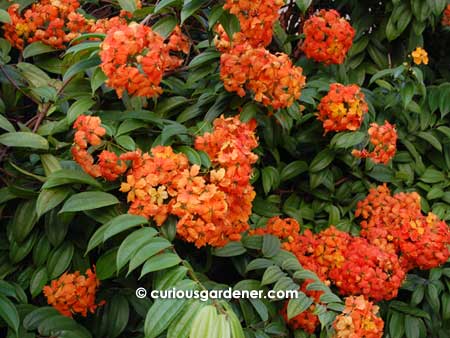We had a dog more than 10 years ago who was a real escape artist. Whenever the mood struck, he’d find a way to get out for a romp around the neighbourhood. Sometimes, he’d slip out when the gate was open. Other times, he’d find or create an opening in the aged chain link fence. When we changed the fence to one that was reinforced with bricks at the bottom, he somehow psyched himself to become a superdog, and learned to jump high enough to lever himself over the top of the 6-foot fence and escape yet again! While the bottom of the fence was brick, the top was still chain link with woven strips of metal, and my “superdog” managed to bend it out of shape with his daily excursions in and out. Mind you, he didn’t hurdle over it; he jumped high enough to claw and pull himself over it – no laughing matter as it was high from the ground, and he was, well, a boy dog. ![]() So there we were, with a new fence that was already damaged, and I wanted to hide that as quickly as possible with a nice, thick-growing and pretty creeping plant.
So there we were, with a new fence that was already damaged, and I wanted to hide that as quickly as possible with a nice, thick-growing and pretty creeping plant.
That’s where the bauhinia came in.
We’d seen this lovely, thick foliaged plant growing in gardens and along some of our nicely landscaped roads in Singapore and just fell in love with the big clusters of deep orange flowers. It seemed like just the thing to conceal our ugly fence and help us forget that it was damaged.
One of my aunts had a lovely trellis of bauhinia in her garden, and she gave us seeds and cuttings together with the caution that it was a difficult plant to propagate. I was over-optimistic and she was right. We never managed to get a seed to sprout, nor a cutting to survive, and had to resort to buying a young plant from the nursery.
I eagerly planted the 40cm high plant by the fence, and waited impatiently for it to grow and hide the evidence of my dog’s bad behaviour. It’s a good thing I didn’t hold my breath waiting, because I’d be dead by now. That plant sat there, shedding and growing new leaves for about two years, but didn’t grow any taller. We amended the soil and put all kinds of fertilizers and enticements to grow, but it absolutely refused to do anything more.
Then, one day, one of my favourite aquarium fish died. I decided to bury it by the bauhinia plant. It seemed appropriate – the fish was a rosy barb – orange in colour, as were the flowers of the bauhinia plant.
I didn’t expect anything to happen – by this time I was pretty jaded with our bauhinia – but within weeks, the plant suddenly exploded with growth! I had to scramble and set up supporting stakes to train it to grow upwards to (finally!) cover up the ugly fence.
From that point, there was no stopping the plant. It grew up, spread along the top of the fence and did what we’d wanted it to do. Then it began to ramble onto and all over a palm tree clump that we had planted near the wall when we thought the bauhinia wasn’t going to take off. Needless to say, the bauhinia plant is well established now and I am much more relaxed where it is concerned. It doesn’t need any more special treatment, although I once in a while toss some fertilizer it’s way. But I don’t need to, really, because the roots have grown quite a ways along the wall, running near other plants that do receive fertilizers on a regular basis.
The flowers are stunning when the plant is in bloom – and it usually is, most of the time. Passersby occasionally help themselves to cuttings and flowers, and neighbours have asked for seeds and cuttings. The plant produces seed pods occasionally – short, broad ones with maybe a pair of seeds inside – but it’s not easy to get those seeds to germinate either. We’ve found that it’s best to let Mother Nature do her job, and on the rare occasion do we discover seedlings growing beneath the mother plant. They’re finicky plants, and have a high mortality rate when young. However, once established, they’re a joy to look at and a pain to prune – because the plant will spread everywhere if left unchecked. So be warned – this plant may be a slow starter, but it will accelerate and keep going when it’s good and ready. It’s a good thing the flowers make it all worthwhile!
© 2010 curiousgardener.com All rights reserved.


